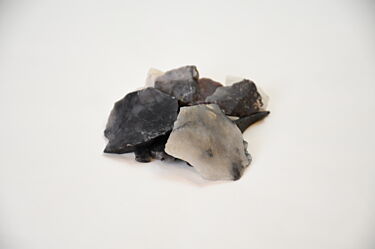
Object of the month: Lithic flakes
These stones are called lithic flakes and are up to 10.000 years old. They were found by the Komsa Mountain.
A lithic flake is made during the production of a stone tool. A stone strikes another stone and a small piece falls off, as a woodchip is made when whittling. This small stone is a lithic flake. It may not look like much, but it is very important to the archaeologist.
Specific marks on the flake tells us that this is not just some insignificant stone; it has a platform on the top, a lump on the back called the bulb of percussion and a point of impact in the same area to name a few. It often has sharp edges, but this depends on the type of rock used. All of this tells us that human hands have processed the stone.
A lithic flake is always a definitive proof that humans from the Stone Age have made artifacts where the flakes are found. It also tells us what type of rock have been used in the area for the production of artifacts. This may furthermore tell us how the humans used and moved around in the landscape. Sometimes the rock used is not native to the area it was found.
So the flake may be the “trash” of artifact production, and the may not be that impressive to look at, but the tiniest of details can reveal a lot about the secrets of prehistory.
These lithic flakes belong to the Tromsø University Museum, part of UiT, the Arctic University of Norway.
Written by Rune Normann, archaeologist